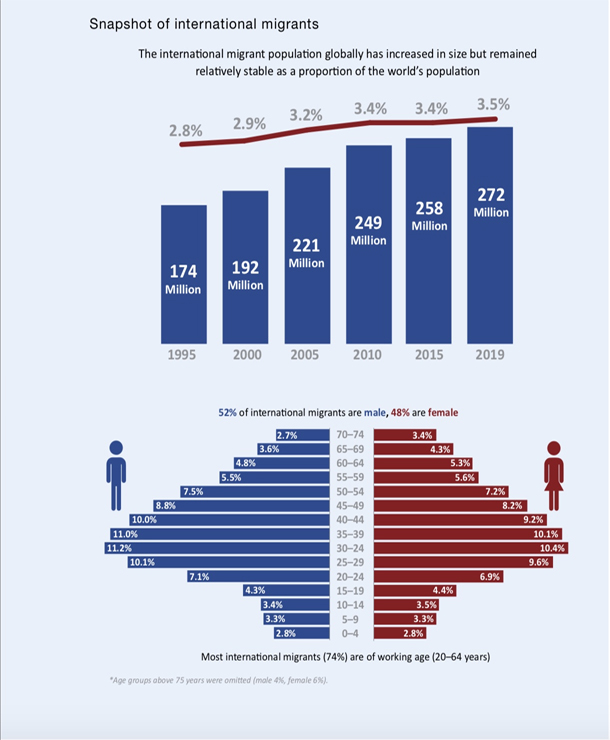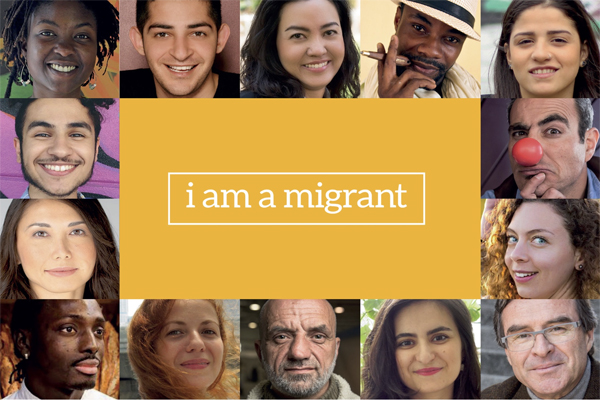Each year on 18th December, the United Nations commemorates International Migrants Day, through the UN-related agency International Organisation for Migration (IOM).
It highlights the contributions made by the roughly 272 million migrants, including more than 41 million internally displaced persons, and challenges they face. The theme of this year’s event is social cohesion – #WeTogether – focusing on the stories of how migrants are building new lives in communities across the globe.
THE DATA
Today, more people than ever live in a country other than the one in which they were born. In 2019, the number of international migrants worldwide – people residing in a country other than their country of birth – reached 272 million (from 258 million in 2017), according to the Global Migration Data Portal. Approximately 31% of the international migrants worldwide reside in Asia, 30% in Europe, 26% in the Americas, 10% in Africa and 3% in Oceania.
Female migrants comprise 48%, and three out of four international migrants are of working age (between 20 and 64 years old). In fact, around 164 million are migrant workers, which is a potentially invaluable talent pool for businesses. It’s also another valid reason to invest in effective diversity and inclusion (D&I) policies.

PROMOTING D&I FOR SOCIAL COHESION
To help promote inclusion of migrants in society, the International Organisation for Migration (IOM) has developed the platform i am a migrant, which features first-hand accounts from individuals, providing insights into the experiences of migrants of all backgrounds and throughout their migratory journeys.
This year’s annual IOM Global Migration Film Festival also showcases films to help understand the promise and challenges of migration.
LEAVING ‘NO-ONE BEHIND”
While many individuals migrate out of choice, many others migrate out of necessity. The number of globally forcibly displaced people topped 70 million for the first time, confirmed the UN. This number includes almost 26 million refugees, 3.5 million asylum seekers, and over 41 million internally displaced persons.
Established in 1951, the IOM is the leading inter-governmental organisation in the field of migration, ensuring the orderly and humane management of migration, to promote international cooperation on migration issues, to assist in the search for practical solutions to migration problems and to provide humanitarian assistance to migrants in need, including refugees and internally displaced people. In 2016, IOM entered into an agreement with the United Nations, to become one of its specialised agencies.
The UN’s 2030 Agenda for Sustainable Development recognises for the first time the contribution of migration to sustainable development. The Agenda’s core aim is to ‘leave no-one behind’ not even migrants, says the UN.
EU STATEMENT
Commenting on International Migrants Day, the European Commission and the High Representative, stated: “On International Migrants Day, we stand strong in our unequivocal commitment to respect and protect the dignity, human rights and fundamental freedoms of all migrants as well as to ensure that migration takes place in a safe, orderly and well-managed way.
“The European Union pursues a comprehensive and sustainable approach to migration. We protect and stand up for those in need. We offer safe, managed and legal pathways. We provide support for successful integration. And, we fight the criminals, human traffickers and smugglers who take advantage of people’s despair.
“Effectively addressing migration requires global cooperation. To benefit from the opportunities that migration brings, we must work together on all its aspects. We must continue to build comprehensive partnerships with countries of origin, transit and destination. Equally, we will continue to cooperate strongly with civil society as well as regional and international organisations.
“Openness and solidarity are core values of the European Union. Europe remains a top destination for the world’s talent. It has always been and will remain a connected continent that embraces international mobility in a way that enables its societies to evolve for the better.”
For more information, on global migration, check out IOM’s World Migration Report 2020.






































